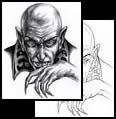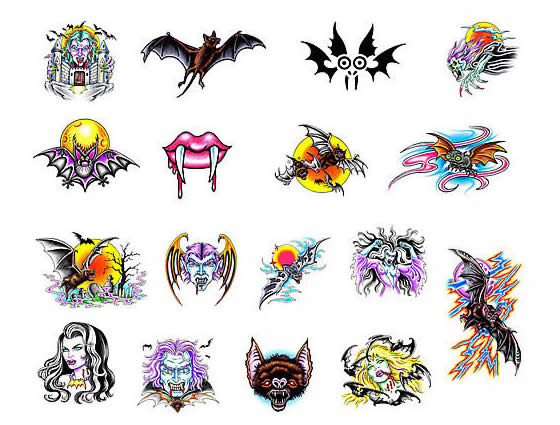|
|
|||
 |
|||
|
TATTOO DESIGNS & SYMBOLS - VAMPIRE TATTOOS
Tattoo Symbol Index - A B C D E F G H I J K L M N O P Q R S T U V W X Y Z Tattoo designs - V >> Vampire
Today's vampire, however, has had a make-over, so that a vampire showing up in a dream - or taking on a vampire tattoo - may reflect more positive associations. Still, it could suggest something in your life that is 'draining' you, or it could reveal a desire for immortality, or a 'thirst' for knowledge. Some of the most graphic vampire tattoos depict female vampires, which have decidedly sexual overtones. And Vampires are the stock in trade look for those in the Goth (short for Gothic) lifestyle. Pale skin, bordering on the bloodless, scarlet lips and an affinity for all things black - from hair to fashion - are the signature look of the Goth.
Vampirism took off as a cult in Slavic societies around the 15th century, where it was a metaphor for those 'outside the Christian faith'. The metaphor expanded to include aristocrats who sucked the blood of the peasant by working him to death, stealing his daughters and depriving him of land. With the arrival of the Industrial Revolution in Western Europe, vampirism was attributed to the cruelty of industrialists who stole the livelihoods of the workers, put their young children to work in factories and drew off their life-blood, leaving them pale and anemic looking. The vampire later became a popular character in Victorian literature, and a symbol of mystery and sexuality. Bram Stoker (1897) created Dracula, an exotic and romantic aristocrat of foreign origin. All that neck-sucking of bare-necked women, all that close body contact, it could be read without offending the sexual morals of stuffy old Victorian England. But this literary vampire was taking on new depths, as a character capable of sorrow, of lamenting lost loves and of 'living' in despair.
Eventually, the vampire crossed the Atlantic Ocean and spread his cloak over America. In the 1920's, a stage production of Bram Stoker's Dracula turned the vampire into a symbol of the sexual revolution of the times. With the arrival of the Great Depression in the 1930s, a vampire character that 'drained the people of their life-blood' drew crowds to the Dracula movies. Though the morality of the era would not allow an immoral and corrupting vampire to be victorious, the sexy Count Dracula was especially attractive to women for whom he was a symbol of 'forbidden fruit' and 'seductive forces' beyond their control. Hollywood further transformed the vampire, creating a blood-thirsty character who showed his softer, sadder side. These new and improved Draculas churned up pity in the audience, as well as terror. Then, author Ann Rice (The Vampire Chronicles) created the vampire with a conscience. They suffered existential angst, conflicted as they were between their desire and their guilt - guilt over knowing that they must kill in order to live. These vampires are tortured outsiders longing for a union that can never be satisfied. They are lovers 'beyond gender'. It certainly did not hurt the box office, when Rice's Vampire Lestat was played by Tom Cruise with Brad Pitt in a supporting role. Vampires never looked so good!
Existing outside the perimeters of society, today's vampire - female as well as male - suffers the guilt of destructive desire, since there's still no question about even the coolest vampire lusting after human blood. But sympathy is beginning to replace fear when coming face to face with the modern vampire. Twilight (by Stephanie Meyers) is the latest development of the vampire myth. Meyers transforms him into an emotionally aware, deeply misunderstood young man with a conscience. Blood-thirsty but in love, he dare not taste his lover's blood, lest his appetites turn deadly. He's the ultimately compelling object of desire for teen-age girls - and gaining an audience with guys, as well.
Get inspired by some really great images and photos in our Vampire Inspiration Gallery
Choose your own vampire tattoo design from Tattoo-Art.com. Choose your Vampire Tattoo Design from TattooJohnny.com Tattoo designs - V >> Vampire Tattoo Symbol Index - A B C D E F G H I J K L M N O P Q R S T U V W X Y Z |
||
| Celeb Tattoos | Facts & Stats | Designs & Symbols | History | Culture | Links | Tattoo Galleries | Contact | |||
|
|
|||








